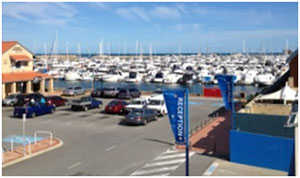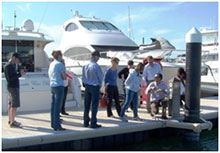Notes from the MPSC Chair

The Marine Pest Sectoral Committee (MPSC) held its fourth meeting in the familiar surroundings of Hillary’s Boat Harbour at the Western Australian Department of Fisheries. Since opening in 1988, Hillarys Boat Harbour has been a premier recreational destination for Perth locals, visitors and has hosted several meetings for the National Introduced Marine Pest Coordination Group (NIMPCG). In addition to numerous boat berths, the harbour offers a wide range of restaurants, attractions, and activities catering to fishermen, boaters, beach goers and tourists.
Marinas are also hubs for marine pest risk. This is because they receive significant amounts of boating traffic and are man-made infrastructure. Marine pests have an advantage here as natural biodiversity is low to resist their colonization. Hillarys Marina is exposed to marine pest risks and we were lucky enough to be shown some practical examples of the research and monitoring projects underway to manage a local incursion of the sea squirt Didemnum perlucidum and other species by the WA Government.

Image: Hillarys Marina, Photo coutesy Michael Sierp
Hillarys also houses the Aquarium of Western Australia. Several of the MPSC meeting attendees toured the aquarium and were impressed with the quality of the displays. One of the displays showcased a species native to Northern Australia which is a significant marine pest overseas - the red lionfish Pteriolis volitans. Interestingly, this fish is a popular aquarium species because of its extravagant visual displays and yet is one of the worst marine pests in the Northern hemisphere where it was introduced to the wild, most probably as someone’s aquarium pet which they let free. The red lionfish has highly venomous spines which have caused countless human injuries. Its voracious appetite has resulted in the significant decline of marine reef fish where it is not native.
Thank you to Rae Burrows, Marion Massam, Justin McDonald, Mike Snow, Matthew Hourston, and the WA Fisheries Aquatic Environment and Research Branch for arranging the meeting venue and the field trip to show us some of WA’s research and development projects. Western Australia has a comprehensive approach to the management of marine pests which sets the current standard. Their efforts were made more difficult by a new marine pest incursion response corresponding with the meetings.
The Asian paddle crab, Charybdis japonica, is a species previously listed as one of our most precarious potential pests if it established in Australia which highlights the importance of our work. Marine pest incursions are increasing in their prevalence in Australia whilst government budgets to combat marine pest risks in most jurisdictions are decreasing significantly.
The Perth meetings, lasting 3 days were amongst the most involved and credit is given to all attendees for their input. A year in the making, the Strategy Day was a success due to the diligence of the small team of Peter Wilkinson, Karina Keast, myself and our two consultants Darren Menachemson and Mark Butz who invested a significant amount of time in preparation.
Thanks to all involved for their input on the day especially for the industry, our New Zealand friends and research representatives for making the trip over to WA. The development of the National Marine Pest Strategy continues and will hopefully be finalised in 2013.
In the other working groups, there appears to be good progress with both government and industry sources endorsing the current directions of our committee in various forums. Several solutions and outcomes have been progressed and the future looks bright for the marine pest agenda receiving a comparable position on the playing field in government which is the collective aim of our committee.
Dr Michael Sierp
Chair MPSC 02-05
Member NIMPCG 15-30
National Marine Pest Strategy Workshop – 23 October 2012
There have been many changes and much progress in marine pest biosecurity since the initiation of the National System for the Prevention and Management of Marine Pest Incursions (the National System) in 2001. In light of this, MPSC is reviewing its objectives to refocus efforts and plan for the future through the development of a national marine pest strategy.
The aim of the strategy is to identify and address key issues within the marine pest sector, and detail strategies which:
- align with, and potentially influence, work under the Intergovernmental Agreement on Biosecurity and the National Environmental Biosecurity Response Agreement
- address key aspects of the National System, and consider its further implementation.
A stakeholder workshop was held prior to the MPSC meeting to begin the development of the strategy. The workshop involved 25 stakeholder participants from government agencies and marine industry sectors.
MPSC will now review the report from the workshop facilitator and begin development of a strategy document.
Industry Workshop and Field Trip
The industry workshop ran smoothly with two good presentations from the WA Department of Fisheries.
Dr Justin McDonald (Principal Research Scientist, WA Marine Biosecurity Research) gave an overview of some of the research and monitoring projects currently underway within the group and plans for future work.
Victoria Aitken (Biosecurity Section Leader, Biosecurity Section) gave a presentation on WA biosecurity policy, highlighting the achievements and innovative developments that lead to the program’s short-listing as a finalist in the WA Premier Awards.
For the duration of the meeting, the hosts, WA Department of Fisheries, displayed a variety of items and information pertaining to marine pest research, compliance and communication activities being undertaken locally. Attendees were also presented with Aquatic Biosecurity Information Packs.

Image: Inspecting pylon wrapping trials
Photo courtesy Marion Massam
Members also toured the Department’s Naturaliste Marine Discovery Centre and some of the marine research laboratories, including the DNA lab. They were then invited to board and tour the Department’s Biosecurity Compliance vessel, the PV Hamelin. The vessel’s master spoke about the various activities involved and demonstrated the navigation system and other technology on board.
The Department’s biosecurity researchers also guided members around several research trial sites at Hillarys Marina. These included demonstrations of:
Wrapped pylon – plastic wrap covering a heavily biofouled pylon to trial this technique for killing biofouling. This involved pipes running down the pylon under the wrap, to deliver freshwater to kill the biofouling organisms.

Image: Didemnum perlucidum
Photo courtesy Marion Massam
Recent incursion of Didemnum perlucidum - a highlight of this part of the tour was the examination of a piece of D. perlucidum taken by hand from the underside of the jetty on which everyone was standing. This colonial ascidian is a recent introduction to WA, and is a target of research.
Settlement arrays - one of the Department’s researchers explained experiments being undertaken in the area to investigate the attachment of D. perlucidum to settlement arrays.

Image: Settlement arrays
Photo courtesy Marion Massam
Snake eye camera – a portable cam unit was used to view underwater objects with the assistance of the Department’s marine research group.
MPSC04 Meeting Notes – 25 October 2012
Jurisdictional reports
Committee members provide reports to each MPSC meeting summarising marine pest biosecurity activities within each member jurisdiction. New Zealand (an MPSC observer) also provided a report to MPSC04.
Key activities reported to MPSC04 include:
- WA has produced a ‘values’ map for the Kimberley coast which shows marine assets (such as marine parks, fishing areas etc) and the potential areas of risk for marine pest incursions. This map will assist in incident response planning and management.
- WA and SA are continuing trials of the Introduced Marine Pest Protector for recreational vessels.
- Following recent public consultation, Victoria is planning to release a new policy for management of invasive species by the end of 2012.
- The Port of Darwin is currently being monitored as part of the dredge and Spoil Disposal Management Plan for the new gas development works in the harbour. This monitoring is expected to meet MDAP standards.
- NZ is planning to release its Biofouling Health Import Standard (IHS) by the end of 2012. The standard includes voluntary biofouling management requirements for the first four years.
Aquaculture biofouling management guidelines
The draft National aquaculture biofouling management guidelines have been re-structured on a production system basis. Industry and jurisdictional stakeholders will now be consulted with a view to achieving endorsement of a final version at MPSC05.
These guidelines are part of a set of national biofouling management guidelines aimed at providing practical information for vessel operators and managers of marine based enterprises.
National Monitoring Network Cost Sharing Working Group
MPSC has re-established the Cost Sharing Working Group to review options for funding of monitoring at National Monitoring Network locations. The working group has now been re-named the National Monitoring Network Cost Sharing Working Group to better reflect the scope of the working group. Terms of reference for the working group will be developed and presented to MPSC for confirmation out-of-session and the working group will report to MPSCO5 in May 2013.
Australia’s marine diagnostic capacity
A Diagnostics Working Group has been established to address Australia’s diagnostic capacity to manage marine pest issues. By MPSC05 the working group is aiming to have prepared an up-to date list of Australian marine taxonomists, undertaken a gap analysis for marine pest identification diagnostics and completed a feasibility study for a National Marine Pests Diagnostics Clearing House.
International meetings
IMO-MEPC 64 update
The 64th session of IMO’s Marine Environment Protection Committee (MEPC) was held in London in early October 2012.
It is anticipated that the IMO Ballast Water Management Convention is likely to come into force in 2014-15. The criterion for a minimum of 30 signatories to the convention has been exceeded but it is expected that it will be another 12 months before the second criterion of 35% of global shipping is achieved. The convention will come into force 12 months after both criteria have been met.
Upcoming MPSC meetings
The Committee has agreed that MPSC meetings will rotate around the jurisdictions with upcoming meetings planned as follows:
- MPSC05: 2 May 2013 in South Australia
- MPSC06: October 2013 in Victoria
Member Information
| Member | Jurisdiction | Agency | Contact |
|---|---|---|---|
| Michael Sierp (Chair-MPSC 04) |
South Australia | Biosecurity SA | michael.sierp@sa.gov.au 08 8207 7838 |
| Karina Keast | Australian Government | Department of Agriculture, Fisheries and Forestry | IMS-Program@agriculture.gov.au |
| Joanne Nathan | Australian Government | Department of Sustainability, Environment, Water, Population and Communities | |
| Rae Burrows | Western Australia | Department of Fisheries | Rae.Burrows@fish.wa.gov.au |
| Jane Frances | New South Wales | Department of Primary Industries | aquatic.pests@industry.nsw.gov.au Aquatic Pests Hotline - Ph: 02 4916 3877 |
| Murray Barton | Northern Territory | Department of Resources | aquaticbiosecurity@nt.gov.au |
| Simon Smith | Victoria | Department of Sustainability and Environment | Simon.M.Smith@dse.vic.gov.au |
| Gabrielle Vivian-Smith | Queensland | Biosecurity Queensland Department of Agriculture Fisheries and Forestry |
gabrielle.vivian-smith@agriculture.qld.gov.au |
| Vic Neverauskas | South Australia | Biosecurity SA | vic.neverauskas@sa.gov.au |
